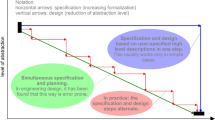Abstract
We wish to model railway control systems in a formally precise way so that product lines can be adapted to specific customer requirements. Typically a customer is a railway operator with national conventions leading to different variation points based on a common core principle. A formal model of the core product must be precise and manipulatable so that different feature variations can be specified and verified without disrupting important properties that have already been established in the core product. Cyber-physical systems such as railway interlocking, are characterised by the combination of device behaviours resulting in an overall safe system behaviour. Hence there is a strong need for correct sequential operation with safety “interlocks” making up a process. We utilise diagrammatic modelling tools to make the core product more accessible to systems engineers. The RailGround example used to discuss these techniques is an open source model of a railway control system that has been made available by Thales Austria GmbH for research purpose, which demonstrates some fundamental modelling challenges.
Access this chapter
Tax calculation will be finalised at checkout
Purchases are for personal use only
Similar content being viewed by others
Notes
- 1.
Actions in Event-B are, in the most general cases, non-deterministic [8].
References
Abrial, J.-R.: Modeling in Event-B: System and Software Engineering. Cambridge University Press, New York (2010)
Abrial, J.-R., Butler, M., Hallerstede, S., Hoang, T.S., Mehta, F., Voisin, L.: Rodin: An open toolset for modelling and reasoning in Event-B. Softw. Tools Technol. Transf. 12(6), 447–466 (2010)
Butler, M., Leuschel, M.: Combining CSP and B for specification and property verification. In: Fitzgerald, J., Hayes, I.J., Tarlecki, A. (eds.) FM 2005. LNCS, vol. 3582, pp. 221–236. Springer, Heidelberg (2005). doi:10.1007/11526841_16
The Enable-S3 Consortium. Enable-S3 European project (2016). www.enable-s3.eu
Dghaym, D., Trindade, M.G., Butler, M., Fathabadi, A.S.: A graphical tool for event refinement structures in event-B. In: Butler, M., Schewe, K.-D., Mashkoor, A., Biro, M. (eds.) ABZ 2016. LNCS, vol. 9675, pp. 269–274. Springer, Cham (2016). doi:10.1007/978-3-319-33600-8_20
Fathabadi, A.S., Butler, M., Rezazadeh, A.: Language and tool support for event refinement structures in Event-B. Formal Aspects Comput. 27(3), 499–523 (2015)
Fürst, A., Hoang, T.S., Basin, D.A., Sato, N., Miyazaki, K.: Large-scale system development using abstract data types and refinement. Sci. Comput. Program. 131, 59–75 (2016)
Hoang, T.S.: An introduction to the Event-B modelling method. In: Romanovsky, A., Thomas, M. (eds.) Industrial Deployment of System Engineering Methods, pp. 211–236. Springer, Heidelberg (2013)
Hoang, T.S., Snook, C., Dghaym, D., Butler, M.: Class-diagrams for abstract data types. In: Van Hung, D., Deepak, K. (eds.) International Colloquium on Theoretical Aspects of Computing–ICTAC 2017. LNCS, pp. 100–117. Springer, Cham (2017). doi:10.1007/978-3-319-67729-3_7
Jackson, M.A.: System Development. Prentice-Hall, Englewood Cliffs (1983)
James, P., Moller, F., Nguyen, H.N., Roggenbach, M., Schneider, S.A., Treharne, H.: On modelling and verifying railway interlockings: Tracking train lengths. Sci. Comput. Program 96, 315–336 (2014)
Leuschel, M., Butler, M.: ProB: An automated analysis toolset for the B method. Softw. Tools Technol. Transf. (STTT) 10(2), 185–203 (2008)
Oliveira, M., Cavalcanti, A., Woodcock, J.: A UTP semantics for circus. Formal Aspects Comput. 21(1–2), 3–32 (2009)
Reichl, K.: RailGround model on github (2016). https://github.com/klar42/railground/. Accessed 20 Apr 2017
Said, M.Y., Butler, M., Snook, C.: A method of refinement in UML-B. Softw. Syst. Model 14(4), 1557–1580 (2015)
Schneider, S., Treharne, H.: CSP theorems for communicating B machines. Formal Aspects Comput. 17(4), 390–422 (2005)
Schneider, S., Treharne, H., Wehrheim, H.: A CSP approach to control in event-B. In: Méry, D., Merz, S. (eds.) IFM 2010. LNCS, vol. 6396, pp. 260–274. Springer, Heidelberg (2010). doi:10.1007/978-3-642-16265-7_19
Snook, C.: iUML-B state-machines. In: Proceedings of the Rodin Workshop 2014, Toulouse, France, pp. 29–30 (2014). http://eprints.soton.ac.uk/365301/
Snook, C., Butler, M.: UML-B: Formal modeling and design aided by UML. ACM Trans. Softw. Eng. Methodol. 15(1), 92–122 (2006)
Vu, L.H., Haxthausen, A.E., Peleska, J.: Formal modelling and verification of interlocking systems featuring sequential release. Sci. Comput. Program. 133, 91–115 (2017)
Woodcock, J., Cavalcanti, A.: The semantics of Circus. In: Bert, D., Bowen, J.P., Henson, M.C., Robinson, K. (eds.) ZB 2002. LNCS, vol. 2272, pp. 184–203. Springer, Heidelberg (2002). doi:10.1007/3-540-45648-1_10
Acknowledgement
This work has been conducted within the ENABLE-S3 project that has received funding from the ECSEL Joint Undertaking under Grant Agreement no. 692455. This Joint Undertaking receives support from the European Union’s HORIZON 2020 research and innovation programm and Austria, Denmark, Germany, Finland, Czech Republic, Italy, Spain, Portugal, Poland, Ireland, Belgium, France, Netherlands, United Kingdom, Slovakia, Norway.
Author information
Authors and Affiliations
Corresponding author
Editor information
Editors and Affiliations
Rights and permissions
Copyright information
© 2017 Springer International Publishing AG
About this paper
Cite this paper
Butler, M. et al. (2017). Formal Modelling Techniques for Efficient Development of Railway Control Products. In: Fantechi, A., Lecomte, T., Romanovsky, A. (eds) Reliability, Safety, and Security of Railway Systems. Modelling, Analysis, Verification, and Certification. RSSRail 2017. Lecture Notes in Computer Science(), vol 10598. Springer, Cham. https://doi.org/10.1007/978-3-319-68499-4_5
Download citation
DOI: https://doi.org/10.1007/978-3-319-68499-4_5
Published:
Publisher Name: Springer, Cham
Print ISBN: 978-3-319-68498-7
Online ISBN: 978-3-319-68499-4
eBook Packages: Computer ScienceComputer Science (R0)




